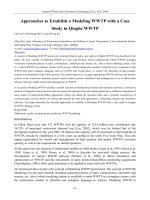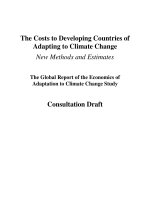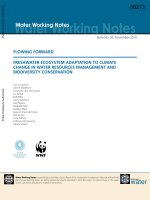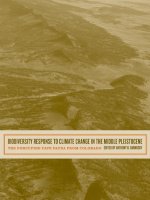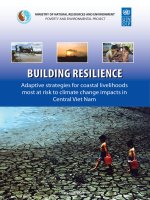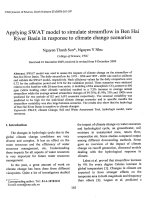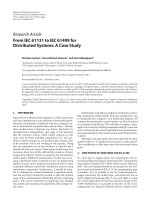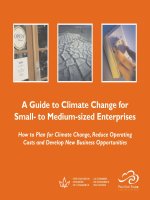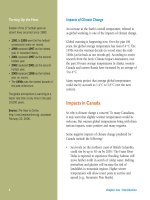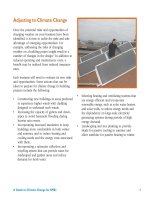Vulnerability assessments to climate change for ecosystem based adaptation case study in van long wetland natural reserve gia vien district ninh binh province
Bạn đang xem bản rút gọn của tài liệu. Xem và tải ngay bản đầy đủ của tài liệu tại đây (1.13 MB, 107 trang )
MINISTRY OF AGRICULTURE AND RURAL DEVELOPMENT
VIETNAM NATIONAL UNIVERSITY OF FORESTRY
***
STUDENT THESIS
VULNERABILITY ASSESSMENTS TO CLIMATE CHANGE FOR
ECOSYSTEM BASED ADAPTATION: CASE STUDY IN VAN LONG
WETLAND NATURAL RESERVE, GIA VIEN DISTRICT,
NINH BINH PROVINCE
Major: Natural Resources Management
Faculty: Forest Resources and Environmental Management
Student: Mai Phuong Thao
Student ID: 145309881
Class: K59A Natural Resources Management
Course: 2014 - 2018
Advanced Education Program
Developed in collaboration with Colorado State University, USA
Supervisor: Nguyen Thi Thanh An
Hanoi, 2018
ABSTRACT
During 2 months conducted this study, I received lots of help and encouragement
from many people without whom this study would have never happened .First and
foremost, I would like to express my sincere gratitude to my advisor Mrs Nguyen Thi
Thanh An for the continuous support of my student thesis study and research, for her
motivation, enthusiasm, and immense knowledge. Her guidance helped me in all the time
of research and writing of this thesis.
Beside my advisor, I would like to thank the administration of Vietnam Forestry
University, Faculty of Forest Resources and Environmental Management, Department of
Environmental with enthusiasm to impart valuable knowledge for us.
My sincere thanks also goes to many people for their contribution to this research;
Mr.Mai Van Quyen- Manager in Van Long NR, Ninh Binh province; in Gia Vien district
who provided me many useful knowledge about local knowledge about ecosystems,
management system and create some great opportunities for me to meet and work with
local people in Van Long NR. I would especially like to thank local people in communes,
they spent more time answering lots of question related to climate change impacts and
preparedness and help me to understand situation and challenges they are facing.
Finally, I would further like to thank my family, who always support and helped me
in my research.
Hanoi, 29 August 2017
Mai Phuong Thao
i
TABLE OF CONTENTS
ABSTRACT.............................................................................................................................. i
TABLE OF CONTENTS......................................................................................................... ii
LIST OF FIGURE .................................................................................................................. iv
LIST OF TABLE ..................................................................................................................... v
GLOSSARY OF TERMS USED IN THE THESIS ............................................................... vi
ABBREVIATION ................................................................................................................ viii
Keyword................................................................................................................................ viii
CHAPTER 1.INTRODUCTION ............................................................................................. 1
1.1. Introduction and problem statement ................................................................................. 1
1.2. Study site........................................................................................................................... 3
CHAPTER 2.RESEARCH OBJECTIVES .............................................................................. 5
2.1. Research goal .................................................................................................................... 5
2.2. Research objectives........................................................................................................... 5
2.3. Research questions ............................................................................................................ 5
CHAPTER 3.METHODOLOGY ............................................................................................ 6
3.1. Research framework ......................................................................................................... 6
3.2. Data collection .................................................................................................................. 7
3.2.1. Secondary data ............................................................................................................... 7
3.2.2. Primary data ................................................................................................................. 11
3.3. Data analysis methods .................................................................................................... 12
3.3.1. CAM process ............................................................................................................... 13
3.3.2. Object, variables and tools in Vulnerability assessment.............................................. 15
CHAPTER 4.RESULTS AND DISCUSSION ...................................................................... 25
4.1. Defining social-ecological systems profile in Van Long NR ......................................... 25
4.1.1. Ecological profile ......................................................................................................... 25
4.1.2. Social profile ................................................................................................................ 27
ii
4.1.3. Economical profile ....................................................................................................... 28
4.1.4. SESs Profile ................................................................................................................. 29
4.2. Assessing potential impacts and vulnerability of SESs in Van Long NR to climate
change .................................................................................................................................... 30
4.2.1. Exposure ...................................................................................................................... 31
4.2.2. Potential impact assessment......................................................................................... 36
4.2.3. Vulnerability assessment ............................................................................................. 42
4.3. Section summary............................................................................................................. 48
4.4. Proposing Ecosystem-based Adaptation (EbA) intervention(s) for Van Long NR ........ 52
5.2. Limitations and suggestions further studies.................................................................... 55
CHAPTER 5.CONCLUSION ............................................................................................... 58
REFERENCES ...................................................................................................................... 60
APPENDICE
iii
LIST OF FIGURE
Figure 1. Research framework ............................................................................................... 6
Figure 2. ICEM CAM methodology .................................................................................... 14
Figure 3. Ecosystem-based Adaptation conceptual framework........................................... 15
iv
LIST OF TABLE
Table 3.1. Detail about data collection and sources .............................................................. 9
Table 3.2. General information about interviewees ............................................................. 11
Table 3.3. Impact matrix ...................................................................................................... 22
Table 3.4. Vulnerability matrix............................................................................................ 24
Table 4.1. Social-ecological systems in Van Long NR ....................................................... 30
Table 4.2. Climate stress degree .......................................................................................... 31
Table 4.3. Future trend of climate........................................................................................ 33
Table 4.4. Exposure level .................................................................................................... 35
Table 4.5. Sensitivity level of SES in Van Long NR .......................................................... 37
Table 4.6. Impact level of climate change on SESs in Van Long NR ................................. 39
Table 4.7. Adaptive capacity of social ecological system in Van Long NR ....................... 42
Table 4.8. Vulnerability assessment .................................................................................... 45
Table 4.9. Potential Impacts to and Vulnerability of SESs by same threats........................ 49
Table 4.10. Potential Impacts and Vulnerability caused by threats to SESs ....................... 51
v
GLOSSARY OF TERMS USED IN THE THESIS
Climate change (CC): the change of climate status from the average state and/or the
climate variability in a long period of time, usually several decades or longer. Climate
change may be due to the internal natural processes or external impacts, or human
activities including land use process which cause changes in the composition of the
atmosphere.
CAM: A method of assessing the vulnerability to climate change based upon the
factors of Exposure, Sensitivity and Adaptive capacity.
EbA: Ecosystem-based approaches to adaptation (EbA) are defined by the
Convention on Biological Diversity (CBD)1 as “the use of biodiversity and ecosystem
services to help people adapt to the adverse effects of climate change, as part of an overall
adaptation strategy” (CBD Secretariat, 2009)
Exposure: degree of climate stress upon a particular unit (of populations, resources,
property, and so on); it may be represented as changes in climate conditions. It is
characterized by intensity, frequency, or the magnitude of climate of variation events or
patterns.
Sensitivity: degree to which a system will be affected by, positively or negatively,
climate change. The consequence can be direct (such as changes in plant productivity due
to changes in temperature) or indirect (such as damages caused by increased flood
frequency, which is a result of sea level rise).
Ecosystem: A dynamic complex of plants or animals, and microorganism‟s
population and their non-living environment interacting as a functional unit. Humans make
an integral part of the ecosystem.
Socio-ecological systems (SESs) Socio-ecological systems (referred also as humanenvironment systems, or human -nature systems) emphasize that human beings and the
vi
nature are interconnected, interactive in a continuous manner and mutually develop, thus,
become integral systems. There is no single definition of SESs. Systems theory
differentiates various types of systems, which include functional, structural and
hierarchical systems with different attributes such as being closed, open, static, dynamic,
simple or complex. SESs is characterized by dynamic complexity with multi-forms and
multi-variables. The specific attributes of a system depends on the selected definition
(Hummel et al. 2011). In term of vulnerability assessment, researcher developed approach
to identify and analyze SESs for the purpose of vulnerability assessment and identification
of Ecosystem based Adaptation solutions, not recommending on how to recognize and
identify Social-Ecological System separately.
Adaptive Capacity: The ability of a system to adjust to climate change (including
climate variability and extremes) to moderate potential damages, to take advantage of
opportunities, or to cope with the consequences
Adaptation: adjustment in natural or human systems in response to the current or
expected impacts of climate change to mitigate climate change risks.
Climate Change Adaptation (CCA): is the adjustment in the natural systems or in
human activities in order to cope with the current or expected impacts of climate to
mitigate climate change risks in the future and to recognize and take advantages of the
benefits from climate change.
Vulnerability: the extent that a system is vulnerable or unable to cope with the
adverse impacts of climate change, including climate change and extreme weather events
(IPCC 2014).
vii
ABBREVIATION
AC
Adaptive capacity
CC
Climate change
CCA
Climate Change Adaptation
CAM
Climate change adaptation and mitigation methodology
CBD
Convention on Biodiversity
EbA
Ecosystem-based Adaptation
ICEM
International Centre for Environmental Management
IMHEN
Institute for Meteorology, Hydrology, and Environment
MONRE
Ministry of Natural resources and Environment
NR
Nature reserve
SESs
Social-ecological systems
VA
Vulnerability Assessment
VND
Vietnam Dong
Keyword: Ecosystem-based Adaptation, Vulnerability, Social Ecology System
viii
CHAPTER 1. INTRODUCTION
1.1. Introduction and problem statement
Climate change, include sea level rise and unpredictable extreme weather events
such as thunderstorms, storms, tropical low pressures will be the most serious challenge to
low and relatively flat areas, especially fresh wetland areas. Wetland conservation to
against climate change and maintaining the ecosystem services from it is crucial. Wetlands
have high biodiversity and play an important role in economic and social development
because it brings several ecosystem services such as: environmental protection and disaster
prevention, the accumulation and limitation of environmental pollution, climate regulation,
maintaining biodiversity and protecting the environment, balance of O2, atmospheric CO2,
local climate regulation (rainfall, temperature, humidity) and reduce the greenhouse effect.
Wetlands also make communities more resilient to the impacts of climate change. They
reduce the impacts from floods, droughts, and cyclones and provide buffers against sea
level rise and storm surges. Wetlands conservation, sustainable use, and restoration can
contribute significantly as efficient and effective nature-based solutions for local
community to mitigate and adapt with climate change impacts. This is idea of Ecosystembased Adaptation: take advantage of ecosystem to mitigate or adapt with adverse effects
from climate change. Ecosystem- based adaptation solutions have been applied in many
regions.
Viet Nam is a natural disaster-prone country, which is particularly vulnerable to the
effects of climate change. Growth population, urbanization, and rapid economic
development impact issues have collided to threaten the country‟s sustainable
development. Regarding wetland management, wetlands play a vital role in the lives of the
local people and the socio-economic development of the country. Wetland is very diverse
with an area of approximately 5,810,000 ha, accounting for about 8% of all wetlands in
1
Asia, of which freshwater wetland accounts for about 10% of total wetlands Among
Vietnam's wetlands, there are 68 wetland areas (341,833 ha) with biodiversity and
environmental importance in many different forms (Ministry of Technology and
Environment, 2001). However, available data and information about the location and status
of wetlands, as well as legal frameworks and management policies relating to wetlands
have been dispersed and incomplete. The lack of a common framework for vulnerability
assessment and measuring adaptive capacity has led to gaps in mainstreaming of potential
solutions in policy and society to help social-economical system as well as ecosystem deal
with climate change due to shortage of information and approaches to implement or
monitor the contribution of ecosystems to adaptation.
There is need for a common framework, methodology and indicators to be used for
vulnerability and adaptive capacity assessment, which should include both socioeconomic
and biophysical variables and measures of economic strengths, human capacities and
environmental capabilities for wetland nature reserve. Also, there are only few researches
and studies about vulnerability of inland wetland areas for effective responses to climate
change. There is also need for vulnerability assessment and adaptation planning in a
participatory manner. And in term of proposing nature-based solutions response to climate
change adverse effects for Van Long NR in sustainable manners, I conducts the study:”
Vulnerability Assessments to climate change for Ecosystem based Adaptation: Case
study in Van Long Wetland Natural Reserve, Gia Vien District, Ninh Binh Province”
2
1.2. Study site
Van Long is one of the largest North Vietnam inland wetland, is located in Gia
Vien district, Ninh Binh province. It is about 90 kilometers from Hanoi to the south and 20
kilometers from Ninh Binh city to Van Long nature reserve. Since 1960, more than 30 km
of a dike system was built on the left bank of the river that made 3,500 ha in Van Long
became a wetland, allowing migratory birds feeding and promoting biodiversity. In 1999,
it became a nature reserve, listed as a wetland protected area and special-use forest in
Vietnam. The isolated limestone mountains surround by watercourse "accidentally"
became the salvation of many animals and plants escape from human destruction.
Van Long NR is located on the administrative boundary of 7 communes of Gia
Vien district: Gia Hung, Lien Son, Gia Van, Gia Lap, Gia Tan and Gia Thanh. In the north,
it adjacent to Hoa Binh province; southward is Cot lagoon; east side is Ha Nam province
and the west is Xich Tho commune, Nho Quan district, Ninh Binh province. Van Long has
been put into operation since 1998 and now it is an attractive tourist destination of Vietnam
with largest white-tailed langur population in Vietnam. Van Long has the craggy and steep
terrain with more than three-quarters of the nature reserve area is limestone ridge. This
ridge has many peaks: Sum (233 m), Mao Ga (308 m), Ba Chon (428 m), Co Tien ( 116 m
), Meo Cao (206 m), Dong Quyen (328 m), May ( 138 m ), Luong (128 m) and Mieu ( 72
m ), stretch from Northwest-Southeast.
There are some vegetation types: natural-regenerated secondary forest on
limestone; formation class shrub and herbaceous vegetation in the dry valley; vegetation at
slope and top of limestone; hygrophilous and aquatic plants. Most of the land area is
covered by vegetation. In addition, cultivation areas, villages in the region are also the
provide food and shelters for many groups of plants and animal. Wetlands area strongly
affected by the hydrological regime of river systems: Day River, Dap River, Lang River,
3
Boi River, and Hoang Long River. The hydrological regime is also dependent on seasonal
rainfall in the year. During the growing season, aquatic plants often absorb all nutrients in
the photic zone, limit the biomass development of phytoplankton and lead to the food
shortage in the aphotic zone. In contrast, during the dry season, vegetation degradation
often causes the anaerobic benthic zone, hinder the life of oxygenated and edible species.
Thus, dominant animals in the lagoon are herbivorous, plant-based scraps consumers, mud
swallowers, and low oxygen-tolerant species, such as crabs, snails, catfishes.
4
CHAPTER 2. RESEARCH OBJECTIVES
2.1. Research goal
To analyze vulnerability of social ecological systems to climate change to climate
change to propose Ecosystem-based solutions for sustainable management in Van Long
Nature Wetland Reserve, Gia Vien dítrict, Ninh Binh province.
2.2. Research objectives
– To define social-ecological systems (SESs) profile in Van Long Nature Reserve.
– To assess potential impacts and vulnerability of social-ecological systems in Van
Long Nature Reserve to climate change
– To propose Ecosystem-based Adaptation (EbA) intervention(s) for Van Long
Nature Reserve
2.3. Research questions
- What is current state of SESs in Van Long NR?
- What is the vulnerable social ecological system in Van Long NR?
- Which recommendations should be considered to benefits both human and
ecosystems for both sustainable development and climate change adaptation?
5
CHAPTER 3. METHODOLOGY
3.1. Research framework
There are three main steps in this thesis, include data collection, data analysis to
find the result is vulnerability and give recommendations to reduce it. Vulnerability
assessment is the central idea of this thesis. Vulnerability assessment provides the most
important output is the vulnerability level of defined systems. Social ecological system is
the object this vulnerability assessment working on.
The first step is data collection. Two types of data are primary data and secondary
data is collected. Sources and expected outcomes are detailed in section 3.2.
Figure 1. Research framework
The second step is data analysis. This thesis follows CAM process, which includes
5 tasks. Identifying and analyzing SESs is just the first and second tasks, defining systems
for vulnerability assessment. Three crucial variables in vulnerability assessment are
6
exposure, sensitivity and adaptive capacity. Due to differences on system components and
human management capabilities, sensitivity and adaptive capacity are selected and grouped
based on SESs. Exposure uses both primary data for climate stress degree and secondary
data for future trend of climate. Combination of exposure and sensitivity from primary data
is Potential Impacts.
The third step is the result and recommendations. Vulnerability is combination of
the Potential Impact with adaptive capacity from primary data. The aim of any climate
change adaptation solutions, include Ecosystem-based Adaptations, is to reduce the
vulnerability of any systems to the risks of climate change.
3.2. Data collection
From research framework, there are 2 types of data: secondary data and primary
data. Information about data collection and sources is summarized in Table 3.3
3.2.1. Secondary data
There are two secondary data sources, include governmental offices, researches and
studies and Institute for Meteorology, Hydrology, and Environment. Secondary data is
essential for defining the systems which this thesis is working on. Secondary data is also
used in calculating future trends of climatic variability for identifying exposure level. This
climatic variability includes the change in the number of extremely hot days, average
maximum temperature and precipitation. Using climate model, change in these parameters
are figured out.
The first secondary data is governmental offices and researches and studies. This is
statistical data about trend, challenges, and compositions of social, economic and
ecological features. It also provides knowledge about the baseline of systems and
prediction the shifts to systems which will occur irrespective of climate change.
Governmental offices are district statistic office and Van Long NR office. Researches and
7
studies have been used are: “Biodiversity in Van Long NR”, “Relationship between local
people livelihoods and conservation activities in Van Long NR”, “Flora biodiversity in
Van Long NR”, “Status and Recommendations for sustainable ecotourism development in
Van Long, nature wetland reserve”, “Evaluating and assessing community participation in
wild animal conservation, Van Long NR, Ninh Binh province”. To map social-ecological
systems, base maps, boundary maps, ecosystem maps from Van Long NR were collected.
The second secondary data called “Climate model” from the Institute for
Meteorology, Hydrology, and Environment. The future trend of climate parameters
(include temperature, precipitation, and the number of extremely hot days) is calculated
from data called “Climate model‟‟ in form of GRID raster. This Climate model is made by
Institute for Meteorology, Hydrology, and Environment (IMHEN) for both dry season
(from December to May) and wet season (from July to November.
8
Table 3.1. Detail about data collection and sources
Tasks
Defining systems
Outcome
SESs characteristics
Steps
Characterizing SESs
Mapping SESs
Vulnerability assessment for systems
Exposure
Sensitivity
Adaptive capacity
Calculating
Identifying:
Identifying:
Identifying:
change in
Climate stress
Sensitivity
Adaptive capacity
climatic
level
parameters
Source
Secondary data
Primary data
Statistic data from
Governmental
IMHEN,
25 local
25 local people
25 local people
Governmental offices
offices
MONRE
people
Van Long NR
Van Long NR
Management
Management Office
Office manager
manager Leaders of 2
Leaders of 2
villages: Da Han and
villages: Da Han
Vuon Thi
Researches and studies
and Vuon Thi
Required
information
Population
Base map
Labor
Ecosystems
Social composition
distribution map
Main livelihood and
Boundary map
Model and data
Duration,
Past and potential Supports from
related to
intensity,
damages
government
magnitude,
Criteria for 5
Mechanism in
temperature,
precipitation and
livelihood shifts
storms (see
frequency of levels of
extreme
sensitivity
Environment quality
Appendix 7)
events
implementing new
local authorities
solutions
9
Forest/ water quality
knowledge
status
Preparations and
responses to damages
Accessibility(
information and
resource)
Output
Past and existing
situation, trends and
drivers of the SESs
SESs distribution
Future trend of
climate
Climate stress Criteria for
Adaptive capacity of
degree
SESs
Sensitivity level
Sensitivity level
10
3.2.2. Primary data
The primary data is collected from local people and local authority. The sampling
technique chosen was snowball sampling. Primary data collection method was used as the
qualitative method, involves open-ended questions with informal conversation. The
interviews were carried out in person (face to face) with a total of 28 people (25 local
people and managers). The study selected local people who live in study site for more than
30 years. Due to the fact that most of people involve in ecotourism are women, the
majority of interviewees were women. The interviews were focused on three major themes
with 2 types of interviewees:
Table 3.2. General information about interviewees
Types of interviewees
Local people
Local authorities
25 interviewees
3 managers (Van Long NR
(14 women & 11 men)
manager, Da han and Vuon
Thi village header)
Exposure
Climate stress level
Sensitivity
Sensitivity
Criteria for 5 levels of
sensitivity
Themes Adaptive
capacity
Knowledge of local people
Knowledge of local
Accessibility (information and
authorities
resource)
Enable environment
Preparations and responses to damages (Organization capacity)
Required information
Duration, intensity, magnitude,
Accessibility (information and
frequency of extreme events
resource)
Past and potential damages
Supports from government,
11
Preparations and responses to damages Mechanism in implementing
new solutions
Criteria
Lived in study site for more around 30 Direct
years
Job/Responsibility
participated
in
management study site
Farmers, ecotourism worker (sailors), Van Long NR Management
participated households (farmer) in Office manager
forest allocation program
Method
Leaders of 2 villages
Observation
Open-ended questions (see Appendix 2 )
Method sampling
Snowball sampling
Sensitivity, adaptive capacity, and climate stress degree in exposure level is
collected from local people and local authority. Some secondary data is available but many
required information was not available in any governmental offices. In addition, data from
reports and projects of some organizations was not easily accessible by the public.
Exposure level requires knowledge about climate stress degree, include magnitude,
duration, intensity, and frequency of the extreme events, but it is not available. Sensitivity
and adaptive capacity of social-ecological systems are also a critical part for vulnerability
assessment but they are not available, too. So in order to capture sensitivity, adaptive
capacity, and climate stress degree in exposure level, researcher interview local people and
local authorities.
3.3. Data analysis methods
This thesis follows CAM process. The CAM process - Climate change adaptation
and mitigation methodology- includes five primary tasks for adaptation planning.
Vulnerability assessment is third tasks. Ecosystem-based Adaptation is only an option in
12
the fourth task of the CAM process, defining a range of options. In this thesis, researcher
combines the first and second task as system profiles. Vulnerability assessment is third
task, conducted for these systems. And thesis stops at seventh mission, in the fourth task –
select Ecosystem-based adaptation options.
3.3.1. CAM process
The first task of CAM process is determining the systems which will be influenced,
the geographic and sector need to be assessed. In this thesis, ecological, social and
economic factors need to be considered together, as parts of an integrated whole. That is
the reason why “socio-ecological system” (SESs) - social-ecological systems have been
used as a unit for analyzing.
The second task includes 2 goals, include: „describing the past and existing
situation, trends, and drivers of the selected systems‟ is analyzing of past extreme events
and trends of selected systems, requires a baseline assessment conducting and shifts
predicting to systems which will occur irrespective of climate change. And „projecting
climate change threats‟ is finding out the climate change threats, requires climate modeling
and downscaling of future climate and hydrology against various scenarios.
The third task is vulnerability assessment. Impact and vulnerability assessment
include analysis of the projected climatic threats to the target systems. The impact
assessment combines the level of exposure to key system components and assets and their
relative sensitivity to the threats. The vulnerability is a measure which considers the impact
and the capacity of the component or asset to adapt to it.
The fourth task is developing a range of options for integrated adaptation
interventions. With limited resources, it is not possible or necessary to do everything at
13
once so we need to identify priorities. In this thesis, this response is Ecosystem-based
Adaptation, which brings co-benefit to both human and ecosystem.
Source: CAM process, ICEM
Figure 2. ICEM CAM methodology
In the first and second task, it is essential to clearly define Social-Ecological
Systems, which are objects for vulnerability assessment and identification of Ecosystembased Adaptation solutions. Social-ecological systems are made up of 3 factors: key
ecological, social and economic descriptors. The results from this process are Socialecological system profile and Social-Ecological Systems map, which establish an
understanding of past and present status and trends in these systems.
Vulnerability assessment is third task, which able to prioritize the vulnerable socialecological system or components of these systems. Vulnerability assessment aims to
analyze all variables of vulnerability, include exposure, sensitivity and adaptive capacity.
The vulnerability assessment in the thesis based on the framework:
Exposure* Sensitivity = Potential impact (3.1)
Potential impact / Adaptive capacity = Vulnerability (3.2)
In (3.1) function, level Impact is the combination of Exposure level with
Sensitivity, finalized Impact assessment matrix. In function (3.2), impacts level from (3.1)
14
together with Adaptive capacity, bases on Vulnerability assessment matrix, to find out
Vulnerability level.
The final task is recommending potential Ecosystem-based Adaptation to enhance
the strengths and reduce weaknesses. From identified the strengths and weaknesses exist in
these social-ecological systems, Ecosystem-based Adaptation what people should do to
manage it.
Figure 3. Ecosystem-based Adaptation conceptual framework
3.3.2. Object, variables and tools in Vulnerability assessment
Generally, there are six components participate in vulnerability assessment include
object, three variables and two tools. Object is social-ecological system, three variables are
exposure and sensitivity, adaptive capacity, two tools are impact matrix and vulnerability
matrix. Vulnerability of SESs is the final outcome from vulnerability assessment. This is
description about these components.
3.3.2.1. Object
Object of vulnerability assessment is SESs. Impacts from, resilience and
preparedness for climate change do not only focus on natural components but also
communities who rely on ecosystem services from them. To understand the issues and
15
threats caused by climate change to all aspects, this thesis selects “socio-ecological
systems” (SESs). In term of vulnerability assessment and identification of Ecosystembased Adaptation solutions, researcher captures important variables into 3 categories that
made up social-ecological systems: key ecological, social and economic descriptors. SESs
will be used to classify sensitivity and adaptive capacity.
Secondary data from governmental offices and researches and studies are collected
data related to 3 groups: the Ecological profile, Social profile and Economical profile
(Social-economical profile). Categories should be the concern, include past and existing
situation, trends and challenges. This data, in fact, is baseline assessment conducting for
social-ecological systems and predicting the shifts to systems which will occur irrespective
of climate change.
Mapping all of the SESs across the entire Van Long NR is a critical part of this
process. SESs map can be used as a tool in conservation to prioritize the most appropriate
and co-benefits solutions. The ability to map landscape values makes it possible to display
social-ecological hotspots -regions that contain significant social with ecological value.
SES hotspot maps provide a visual tool for land planners and managers that enable the
visualization of human/landscape relationships. The identification of SESs hotspots can
help identify areas of high concern (e.g., conflicting landscape values), areas of intense
sociocultural/biophysical processes (e.g., a highly valued area for recreation which is
physically fragile), or prospective conservation areas with high ecological value but low
social value. All modeling tool outputs and socio-economic analysis can be linked directly
to GIS analysis making it the interpretive core of the integrated assessment and
visualization methodologies.
SES map is visual tool to illustrate ecosystems distribution with local main
livelihood (how can they benefit from ecosystem.) To map SESs in the study site, the
16
